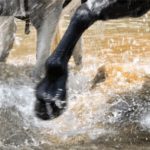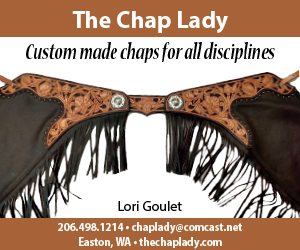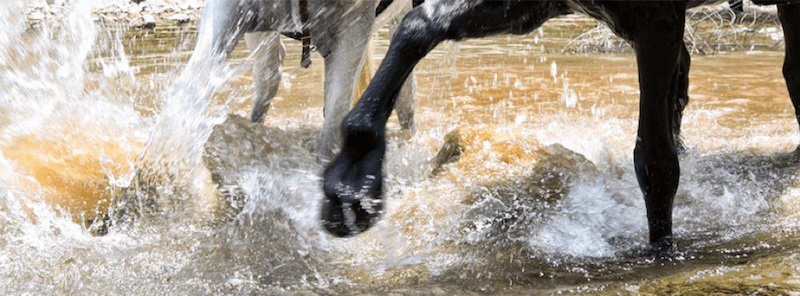Handy Hoof Hints, Part 3

1. Like Your Trimmer
In a wild herd environment, horses will easily travel 10 miles a day foraging for food on rough terrain, naturally trimming their hooves to suit the environment. Your barefoot trimmer must trim your horse to compensate for the lack of movement and also balance the effects of your horse’s domesticity. She should be someone you feel comfortable with, who provides a good answer to any of your questions and who allows you the space and leniency to learn and be a part of what she is doing to your horse’s hoofs. If not, move on.
2. Watch Hoof Mechanics
Good function of the hoof means the heels expand when bearing weight to allow the structure of the horse to descend and the hoof capsule to flex and absorb that shock. Expansion and contraction can be achieved in a combination of ways and by providing frequent trims tailored to the individual barefoot horse on his specific terrain.Good hoof function requires that blood circulates freely, providing nutrients to all the live tissue of the hoof. This is accomplished through unrestrained movement, flexion, and pumping action of a natural bare hoof.
3. Help Your Horse Move
Your horse wants to move. It’s essential for the physiology of his hooves, overall physical well-being, and for his psychological state. He feels better when he’s fit.
Studies have shown that stalled horses with restricted movement have more health and behavior problems than those allowed freedom. Anyone who doubts this is advised to walk into the bathroom and close the door—stand there all day doing nothing, moving minimally, talking to no one. One may develop some odd twitches, anxieties, or crankiness along with a good understanding of how a confined horse feels. And humans only have two legs!
4. The Social Club
Horses exercise more when kept in a herd, where social interaction provides motivation to move. Their hooves function when they are moving—expansion, contraction, and blood circulation. They create hierarchies of order which provide comfort within the herd. They bond and groom and play. They are not meant to be coddled, bedded and pampered like us. Let them be the horses they are. They will have differences of will and opinion, but they will work it out. That’s their job. Sure, there may be some bumps and bruises in the process, but bare hooves cause far less damage or injury than metal shoes!
5. The Need for Water
When horses need hydration, they are happy to stand in a creek or watering hole for a period. Well-hydrated hooves have elasticity which promotes the all–important hoof mechanism. Water also allows for an easier trimming procedure, especially in dry weather; well hydrated hooves are so much easier to work with.
Our domestic horses are given water in buckets, and this compromises their feet. Consider your horse’s environment and add water or a mud pool in an area your horse must move through. Water is preferred over commercial products as many moisturizers available on the market contain alcohol, solvents and other agents that draw moisture out.
As with many authentic solutions, there are often no quick-fix shortcuts. You may have to stand with your horse while soaking. Or you can simply use your Cavallo Hoof Boots. Cover the built-in drainage holes with duct tape and fill the boots with water. Your horse can freely rumble around hydrating his own feet.
6. Provide Hoof Protection
Our domestic mounts no longer move many miles a day foraging for food on hard, dry ground and hydrating hooves in watering holes. Their movement is limited to an average of 2 or 3 rides per week. Their hooves are conditioned to their living environment: grassy pastures and bedded stalls. They are conditioned to tolerate the terrain of their habitat.
But 5% (or even a generous 10%) of the time we ask them to pack us up a gravel trail or hard asphalt road. Their hooves are not accustomed to this terrain and the load is increased with our weight and that of the tack–– about 200 extra pounds. That’s about 20% of their own body weight!
Give your horse the benefit of amazing Cavallo Hoof Boots. Ride through any terrain at any speed with 100% hoof protection. It’s that simple.

The Northwest Horse Source is an independently owned and operated print and online magazine for horse owners and enthusiasts of all breeds and disciplines in the Pacific Northwest. Our contemporary editorial columns are predominantly written by experts in the region, covering the care, training, keeping and enjoyment of horses, with an eye to the specific concerns in our region.






